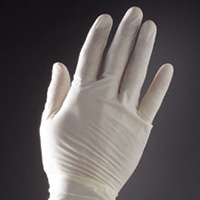Safety Gloves

Protective gloves should be worn when handling hazardous, corrosive or irritating materials, rough or sharp-edged objects, and very hot or cold materials. When handling chemicals in a laboratory, disposable latex, vinyl or nitrile gloves are usually appropriate. These gloves will offer protection from incidental splashes or contact. Cloth gloves should be worn when handling rough or sharp-edged objects or very hot or cold materials. Before each use, gloves should be inspected for discoloration, punctures, and tears.
| Glove Type | Protection | Comments |
| Plastic, disposable (Polyethylene) | Body fluids and small amounts of aqueous solutions. | Loose-fitting. Latex and power free. |
| Latex (Natural Rubber) | Dilute acids, bases and irritating solutions. Not suitable for organic solvents. | Conforms to the hand and allows good finger dexterity. Be careful for latex sensitivities. |
| Neoprene (Synthetic Rubber) | Good for acids, bases, and most organic solvents. | More puncture resistant but may not provide good finger dexterity. |
| Nitrile | Best protection for acids, bases, and organic solvents. Great puncture resistance. | Best all around glove for chemistry and biology labs. |
| Vinyl (PVC) | Suitable for washing dishes and reasonable protection against corrosive materials. Not commonly found in laboratories. | Not suitable for organic solvents. |
| Cloth, cotton | Suitable for handling hot or cold items but they are not fire-proof. | Loose-fitting and only provides brief protection. Difficult to clean. |
| Silicone | Great for handling hot or cold items and are fire-resistant. | Best choice for handling hot materials in the lab. Hot vessel hand gripping devices are commonly made from silicone. |